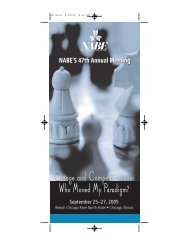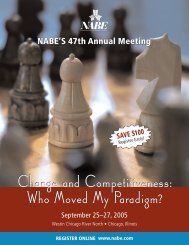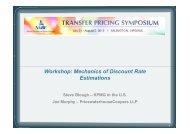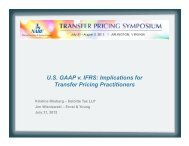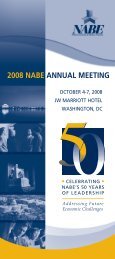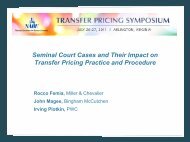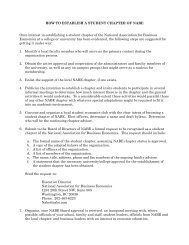An Econometric Analysis of Consumer Sentiment and ... - NABE
An Econometric Analysis of Consumer Sentiment and ... - NABE
An Econometric Analysis of Consumer Sentiment and ... - NABE
- No tags were found...
You also want an ePaper? Increase the reach of your titles
YUMPU automatically turns print PDFs into web optimized ePapers that Google loves.
<strong>An</strong> <strong>Econometric</strong> <strong>An</strong>alysis <strong>of</strong> <strong>Consumer</strong> <strong>Sentiment</strong> <strong>and</strong> Confidence Indexes:Pulling Trigger EffectsWe <strong>of</strong>fer an overview <strong>of</strong> IHS Global Insight's econometric research on the determinants <strong>of</strong> consumer mood, usingtraditional explanatory variables such as gasoline prices, initial unemployment insurance claims, the unemploymentrate, <strong>and</strong> equity prices.In this special report, we <strong>of</strong>fer an overview <strong>of</strong> IHS Global Insight’s research on the determinants <strong>of</strong> consumer attitudesusing traditional explanatory variables as well as psychological “trigger points” from the field <strong>of</strong> behavioral economics.In addition, we give a brief overview <strong>of</strong> behavioral economics. In subsequent articles, we will focus on thedeterminants <strong>of</strong> inflationary expectations <strong>and</strong> Bloomberg's weekly comfort index. Since this report is somewhattechnical <strong>and</strong> lengthy, we have also provided a relatively brief summary as a perspective article: <strong>Consumer</strong> Feelings<strong>and</strong> Economic Reality, by Chris G. Christopher, Jr. (June 6, 2011).The Conference Board's consumer confidence <strong>and</strong> Reuters/University <strong>of</strong> Michigan’s consumer sentiment indices aretwo widely used measures <strong>of</strong> consumer attitudes <strong>and</strong> the factors that drive consumer spending. Personalconsumption represents approximately 70% <strong>of</strong> GDP <strong>and</strong> is a key component in our underst<strong>and</strong>ing <strong>of</strong> business cycles.IHS Global Insight’s large-scale quarterly U.S. econometric model forecasts <strong>and</strong> utilizes the Reuters/University <strong>of</strong>Michigan's consumer sentiment headline <strong>and</strong> short-term inflation expectations indices. <strong>Sentiment</strong> is a driver forvarious inflation-adjusted consumer expenditure components. Inflation expectations affect interest rates, wage rates,<strong>and</strong> the rental cost <strong>of</strong> capital.First, we give a brief overview <strong>of</strong> the current state <strong>of</strong> behavioral economics in the overall context <strong>of</strong> “mainstream"economics. We then discuss the econometric models <strong>and</strong> data used, <strong>and</strong> outline our key findings. Finally, we <strong>of</strong>fersome brief conclusions.The Homo Economicus Assumption <strong>and</strong> Behavioral EconomicsMost modern mainstream economics analysis assumes that individuals behave as Homo Economicus (EconomicHuman). In this analytical framework, individuals behave under a narrowly defined “rationality” with purely selfinterestedmotives, where economic agents are strict “utility” maximizers with not much consideration <strong>of</strong> social,cognitive, or emotional factors in the underst<strong>and</strong>ing <strong>of</strong> human actions. Mainstream economists (Neo- or New-Keynesian, Classical, Neo-Classical, etc.) assume Homo economicus as the starting point in developing theirrespective theories <strong>and</strong>, in most cases, do not consider it necessary to challenge or empirically test this vital <strong>and</strong>highly restrictive assumption. Most other social sciences, however, such as anthropology, sociology, psychology,behavioral sciences, <strong>and</strong> nonmainstream economics, have rejected the concept <strong>of</strong> Homo economicus. There isconsiderable agreement that human actions are rational in many circumstances, but not to the extreme <strong>of</strong> Homoeconomicus—there has to be room for emotions, <strong>and</strong> spontaneous innate urges.The two major nonmainstream economic schools <strong>of</strong> thought—Keynesian/Post-Keynesian (M. Keynes, HymanMinsky) <strong>and</strong> Austrian (Karl Menger, Ludwig Von Misses, F. A. Hayek)—diverge on economic policy prescriptions, butagree that the assumption <strong>of</strong> Homo economicus is erroneous <strong>and</strong> lead to ineffective policy prescriptions. According toJohn Maynard Keynes' The General Theory <strong>of</strong> Employment, Interest <strong>and</strong> Money, "[...] <strong>of</strong> our decisions to dosomething positive, <strong>and</strong> the full consequences <strong>of</strong> which will be drawn out over many days to come, can only be takenas a result <strong>of</strong> animal spirits—<strong>of</strong> a spontaneous urge to action rather than inaction, <strong>and</strong> not as the outcome <strong>of</strong>weighted average <strong>of</strong> quantitative benefits multiplied by quantitative probabilities."[2].1 IHS Global Insight Published 7/1/11




